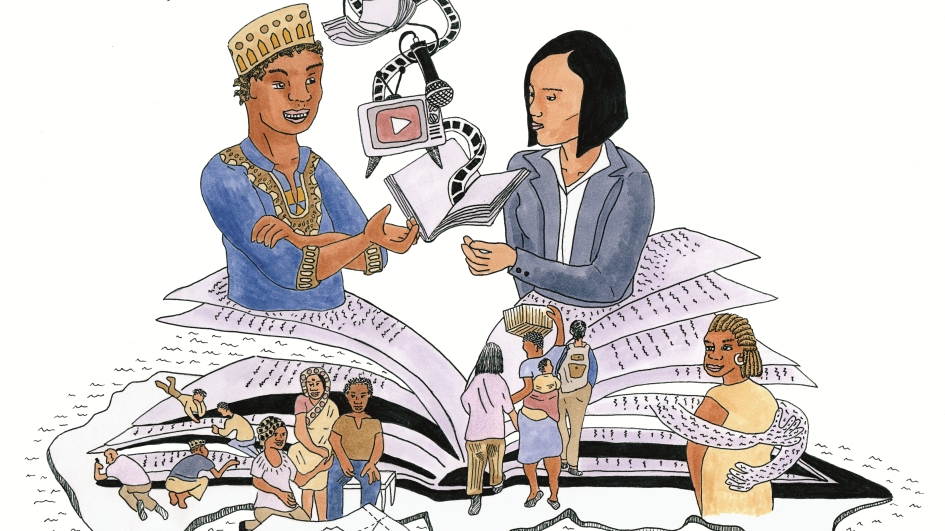
»These tools can be used in multiple ways – they can contribute to the development of an organization and they can be used for communication.«
Stories about us: Storytelling for social entrepreneurs
Barbara Börner has been advising social entrepreneurs and nonprofit organizations for over 18 years. As deputy director of the Canopus Foundation, she directed a number of the foundation’s programs. She now teaches Social Entrepreneurship as part of the international master’s program in Environmental Governance at the University of Freiburg. Together with Siemens Stiftung and adelphi, she developed the program “Stories About Us”, recognizing that stories have potential and can be a valuable instrument for social entrepreneurs striving to reach their networks. Barbara Börner held a number of workshops on this topic in developing countries. All the tools and methods used in those workshops were just published in a handbook of the same name. The handbook is available online.
How can storytelling contribute to the development of an organization?
Storytelling enables us to engage with another perspective, and through storytelling, together we’re able to develop the stories that matter to our enterprises.
Take, for example, a typical startup that experienced a growth spurt early on. New employees who weren’t present for the startup’s early stage often have trouble understanding why the culture of the organization is the way it is. In our workshop, together the team develops the enterprise’s story for the first time. In the process, they learn that the manager pushes as hard as she does because more than once in the startup’s early stage, the enterprise’s very existence was on the line.</p><p> </p><p>In this way, stories often create a gateway to the emotions of others, enabling things to surface that remain hidden when observed from a purely analytical perspective. The wonderful thing is: These storytelling methods work in the most disparate of cultures and contexts. There’s no prerequisite of business school know-how or some other special ability – we all grew up with stories, and we’re all shaped by the stories of our own lives. We have everything we need within us.

The workshops are primarily tailored to social enterprises in developing regions. You’ve just returned from Africa. Do you have an example of what this workshop changed for the participants there?
Social entrepreneurs in particular are often very active and always in pitch mode. They mostly talk about their successes – how well the organization is developing, how many people they’ve been able to reach. The tools we give these entrepreneurs enable them to identify difficult situations as well. Situations people face everywhere, all the time. And they realize those things don’t necessarily make them weaker – quite the opposite, in fact.
During our workshop in Uganda, an entrepreneur told his enterprise’s story and talked about the death of his business partner for the first time. He realized he could talk about it and not stand there looking weak. A consultant who worked with a Safe Water Kiosk in Kenya was able to resolve a conflict in his community with the help of the Storyline Graph tool. The water kiosk was running so well that everyone wanted a slice of the pie, resulting in discord within the community. In the workshop, they all reflected on the enterprise’s first days and reengaged with the moment ten years ago when they built the first dam themselves. Suddenly, they were back to the true substance of the thing: how to keep the kiosk in continuous operation. As these examples demonstrate, intensive engagement with an enterprise’s story enables people to see things from a different and often fresh perspective, making communication easier.
Based on the methods used in the workshops, you created the Storytelling Workbook. Can you offer us a more in-depth explanation of one of the tools included in the book? Is the workbook also suitable for individual use?
We collected people’s experiences through the workshops and incorporated them into the workbook. The purpose was to make it hands-on, pragmatic and easy to implement, even for those working through it on their own. For that reason, the tools and their backstories are explained step-by-step. These tools can be put to a variety of uses – they can contribute to the development of an organization, but they can also be used for communication.
In Plotting Your Stories, we show those engaging with the text how to tell their enterprise’s story in different contexts. The elements I include when talking with an investor for fundraising will be different from the elements I spotlight in conversation with a potential customer. To find the right elements in each context, an entrepreneur needs to break free from the realm of the analytical. The tool Stakeholder Landscape can help with that. To use it, I create a picture of a landscape with representations of my various stakeholders. As social entrepreneurs, we’re part of an ecosystem. In this picture, you might find society divided by a wide river where crocodiles lurk, or you might see investors atop a high mountain. This abstraction leads into some meaningful reflection in the next step, where I think about what roles the various actors are playing. And that, in turn, helps with Plotting Your Stories: I learn to adapt the content of my story to dovetail with the role of my listener. In this way, I can truly reach other people.
November 2018


